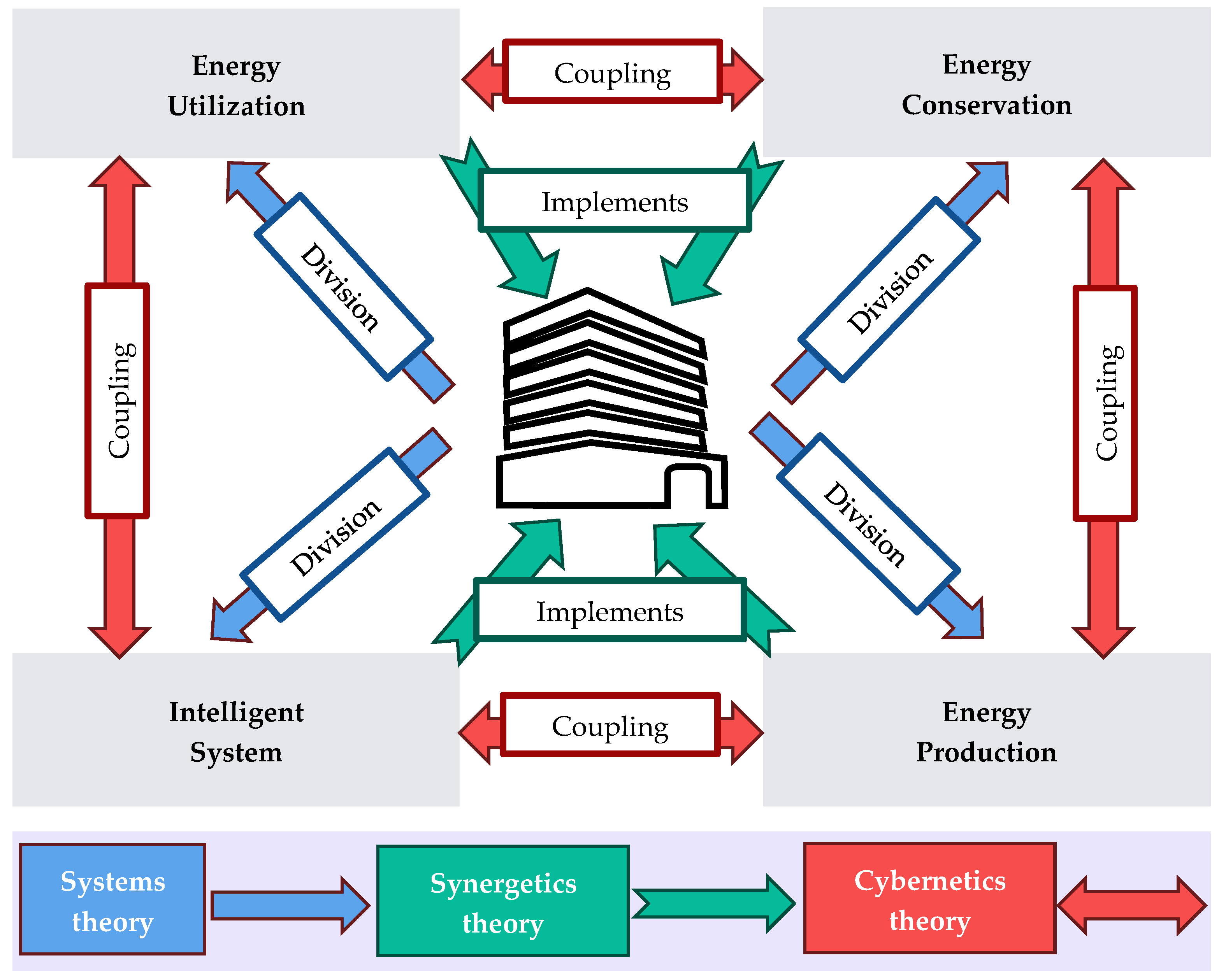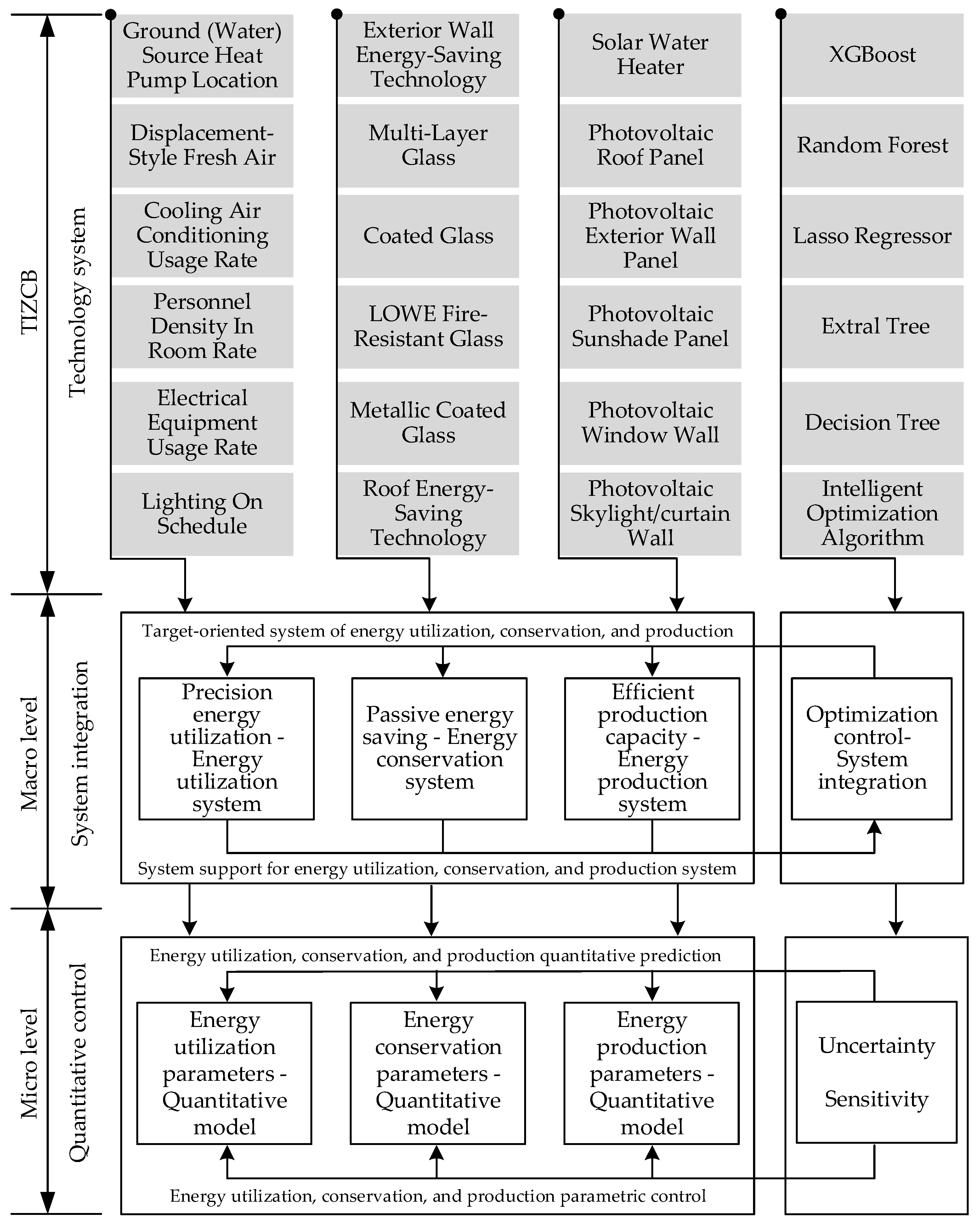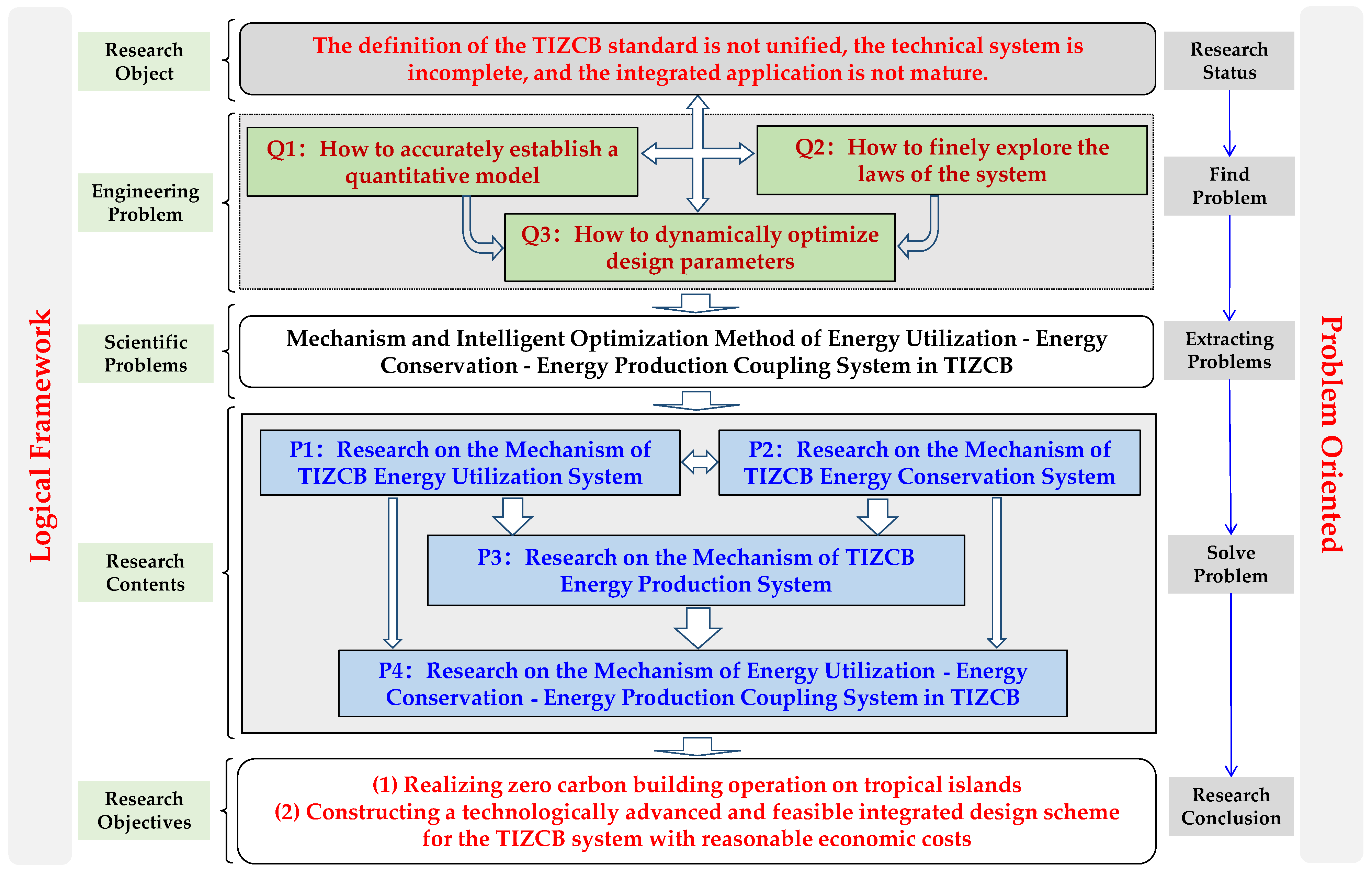Theoretical Framework and Research Proposal for Energy Utilization, Conservation, Production, and Intelligent Systems in Tropical Island Zero-Carbon Building
Abstract
:1. Introduction
2. Conceptual Definition
2.1. Zero-Carbon Buildings
2.2. Tropical Island Architecture
2.3. Tropical Island Zero-Carbon Buildings
2.4. TIZCB Technology System
3. Theoretical Methodology
3.1. System Theory
3.2. Cybernetics
3.3. Synergetics
3.4. Overview of Theoretical Application
4. Establishing a Theoretical Framework
4.1. Macroscopic System Decomposition and Integration
4.2. Microparameter Quantification and Regulation
4.3. Interaction and Coupling of Mesoscopic Systems
4.4. Analysis of Intelligent Systems Based on Macro–Medium–Micro
5. Research Logical Framework
6. Research Implementation Plan
6.1. TIZCB Energy Utilization System Mechanism Research Plan
6.1.1. Research Objectives
6.1.2. Main Contents
- (1)
- Construction of a Parametric Model for the Energy Utilization System in TIZCB
- (2)
- Impact Relationships between the Design Parameters of the Energy Utilization System and Building Performance in TIZCB
- (3)
- Optimization Analysis of the Impact of the Design Parameters of the Energy Utilization System on Building Performance in TIZCB
6.2. TIZCB Energy Conservation System Mechanism Research Plan
6.2.1. Research Objectives
6.2.2. Main Contents
- (1)
- Construction of a Parametric Model for the Energy Conservation System in TIZCB
- (2)
- Impact Relationships between Design Parameters of the Energy Conservation System and Building Performance in TIZCB
- (3)
- Optimization Analysis of the Impact of the Design Parameters of the Energy Conservation System on Building Performance in TIZCB
6.3. TIZCB Production System Mechanism Research Plan
6.3.1. Research Objectives
6.3.2. Main Contents
- (1)
- Construction of a Parametric Model for the Production System in TIZCB
- (2)
- Impact Relationships between the Design Parameters of the Production System and Building Performance in TIZCB
- (3)
- Optimization Analysis of the Impact of the Design Parameters of the Production System on Building Performance in TIZCB
6.4. TIZCB Intelligent System Mechanism Research Plan
6.4.1. Research Objectives
6.4.2. Main Contents
- (1)
- System-Coupled Parametric Modeling of the Intelligent System in TIZCB
- (2)
- Technical Evaluation-Based Optimization and Regulation of the Intelligent System in TIZCB
- (3)
- Decision Assessment of the TIZCB Intelligent System Based on Economic Evaluation
7. Conclusions
- (1)
- This study defines TIZCB, achieving ZCBs during building operation by relying entirely on renewable energy sources. It emphasizes the need for architectural design to adapt to tropical climate conditions, integrate local culture, and utilize innovative technologies and materials. A technical framework is proposed, focusing on energy utilization, energy conservation, energy production, and intelligent technologies, grounded in theories including system theory, control theory, and synergy theory.
- (2)
- Using a macro–meso–micro analytical framework for TIZCB, this study outlines the macro objectives and micro parameter controls of such systems. System theory is employed for goal setting, control theory for parameter prediction, and synergy theory for establishing system interactions, providing a foundation for practical design and optimization.
- (3)
- By integrating systems engineering theory and parametric design technology, this research investigates the impact of design parameter models on the performance of ZCBs. A theoretical framework is established covering energy utilization, energy conservation, energy production, and intelligent systems, offering clear research strategies for implementation.
- (4)
- Through meticulous planning, this study develops parameter models and data-driven analysis for TIZCB, ensuring both zero-carbon operation and economic feasibility. It provides a systematic framework and practical guidance to advance clean energy development in Hainan and China’s dual-carbon strategy.
- (5)
- The TIZCB proposed in this study achieves zero carbon emissions only during the building operation phase. The next step is to advance TIZCB to further reduce carbon emissions from a whole lifecycle perspective; on the other hand, the framework and technical solutions proposed in this study still need to be validated in actual cases.
Author Contributions
Funding
Data Availability Statement
Conflicts of Interest
References
- Kongboon, R.; Gheewala, S.H.; Sampattagul, S. Greenhouse gas emissions inventory data acquisition and analytics for low carbon cities. J. Clean. Prod. 2022, 343, 130711. [Google Scholar] [CrossRef]
- Too, J.; Ejohwomu, O.A.; Hui, F.K.P.; Duffield, C.; Bukoye, O.T.; Edwards, D.J. Framework for standardising carbon neutrality in building projects. J. Clean. Prod. 2022, 373, 133858. [Google Scholar] [CrossRef]
- Hao, J.; Gao, F.; Fang, X.; Nong, X.; Zhang, Y.; Hong, F. Multi-factor decomposition and multi-scenario prediction decoupling analysis of China’s carbon emission under dual carbon goal. Sci. Total Environ. 2022, 841, 156788. [Google Scholar] [CrossRef] [PubMed]
- China Building Energy Conservation Association. 2022 China Urban and Rural Construction Carbon Emission Series Research Report. 2023. Available online: https://www.cabee.org/site/content/24420.html (accessed on 7 October 2023).
- The Central People’s Government of the People’s Republic of China. Notice of the Ministry of Housing and Urban Rural Development on Issuing the 14th Five Year Plan for Building Energy Conservation and Green Building Development. 2022. Available online: https://www.gov.cn/zhengce/zhengceku/2022-03/12/content_5678698.htm (accessed on 7 October 2023).
- Notice of the Central People’s Government of the People’s Republic of China. Ministry of Science and Technology and Nine Other Departments on Issuing the Implementation Plan for Science and Technology to Support Carbon Peaking and Carbon Neutrality (2022–2030). 2022. Available online: https://www.gov.cn/zhengce/zhengceku/2022-08/18/content_5705865.htm (accessed on 7 October 2023).
- Moghayedi, A.; Michell, K.; Hübner, D.; Jeune, K.L.; Massyn, M. Examine the impact of green methods and technologies on the environmental sustainability of supportive education buildings, perspectives of circular economy and net-zero carbon operation. Facilities 2023, 42, 201–222. [Google Scholar] [CrossRef]
- Scherz, M.; Passer, A.; Kreiner, H. Challenges in the achievement of a net zero carbon built environment—A systemic approach to support the decision-aiding process in the design stage of buildings. IOP Conf. Ser. Earth Environ. Sci. 2020, 588, 032034. [Google Scholar] [CrossRef]
- Leung, M.; Tong, X.; Tong, J.; Lee, P. Airborne bacterial assemblage in a zero carbon building: A case study. Indoor Air 2018, 28, 40–50. [Google Scholar] [CrossRef]
- Bui, T.T.P.; Domingo, N.; Macgregor, C.; Wilkinson, S. Zero carbon refurbishment for existing buildings: A literature review. IOP Conf. Ser. Earth Environ. Sci. 2022, 1101, 022017. [Google Scholar] [CrossRef]
- Zhao, X.; Pan, W. Co-productive interrelations between business model and zero carbon building: A conceptual framework. Built Environ. Proj. Asset Manag. 2017, 7, 353–365. [Google Scholar] [CrossRef]
- Pan, W.; Ning, Y. A socio-technical framework of zero carbon building policies. Build. Res. Inf. 2014, 43, 94–110. [Google Scholar] [CrossRef]
- Girard, S.; Mckoen, K.; Koch, A. Towards a neighbourhood scale for low- or zero-carbon building projects. Build. Res. Inf. 2012, 40, 527–537. [Google Scholar] [CrossRef]
- Bui, T.T.P.; Macgregor, C.; Wilkinson, S.; Domingo, N. Towards zero carbon buildings: Issues and challenges in the New Zealand construction sector. Int. J. Constr. Manag. 2022, 23, 2709–2716. [Google Scholar] [CrossRef]
- Nidhin, B.K.S.N.; Domingo, N.; Bui, T.T.P.; Wilkinson, S. Construction stakeholders’ knowledge on zero carbon initiatives in New Zealand. Int. J. Build. Pathol. Adapt. 2023. ahead of print. [Google Scholar] [CrossRef]
- Hasan, L.; Lizarralde, G.; Lachapelle, E. The problem with net zero building policy: Rreflecting on the making, and future, of a global discourse. IOP Conf. Ser. Earth Environ. Sci. 2023, 1196, 012002. [Google Scholar] [CrossRef]
- Torriti, J.; Lees, T.; Schweber, L. Framing evidence: Policy design for the zero-carbon home. Build. Res. Inf. 2015, 43, 420–434. [Google Scholar] [CrossRef]
- Walker, G.; Karvonen, A.; Guy, S. Reflections on a policy denouement: The politics of mainstreaming zero-carbon housing. Trans. Inst. Br. Geogr. 2016, 41, 104–106. [Google Scholar] [CrossRef]
- Lees, T.; Sexton, M. An evolutionary innovation perspective on the selection of low and zero-carbon technologies in new housing. Build. Res. Inf. 2014, 42, 276–287. [Google Scholar] [CrossRef]
- Steijger, L.A.; Buswell, R.A.; Smedley, V.A.; Firth, S.K.; Rowley, P. Establishing the zero-carbon performance of compact urban dwellings. J. Build. Perform. Simul. 2013, 6, 319–334. [Google Scholar] [CrossRef]
- Mcleod, R.S.; Hopfe, C.J.; Rezgui, Y. An investigation into recent proposals for a revised definition of zero carbon homes in the UK. Energy Policy 2012, 46, 25–35. [Google Scholar] [CrossRef]
- Liu, Y.; Xue, S.; Guo, X.; Zhang, B.; Sun, X.; Zhang, Q.; Wang, Y.; Dong, Y. Towards the goal of zero-carbon building retrofitting with variant application degrees of low-carbon technologies: Mitigation potential and cost-benefit analysis for a kindergarten in Beijing. J. Clean. Prod. 2023, 393, 136316. [Google Scholar] [CrossRef]
- Kalbasi, R.; Afrand, M. Which one is more effective to add to building envelope: Phase change material, thermal insulation, or their combination to meet zero-carbon-ready buildings? J. Clean. Prod. 2022, 367, 133032. [Google Scholar] [CrossRef]
- Manyumbu, E.; Martin, V.; Chiu, J.N. Prospective PCM–desiccant combination with solar-assisted regeneration for the indoor comfort control of an office in a warm and humid climate—A numerical study. Energies 2023, 16, 5391. [Google Scholar] [CrossRef]
- Matias, M.L.; Carlos, E.; Branquinho, R.; Valle, H.D.; Marcelino, J.; Morais, M.; Pimentel, A.; Rodrigues, J.; Monteiro, T.; Fortunato, E.; et al. A comparison between solution-based synthesis methods of ZrO2 nanomaterials for energy storage applications. Energies 2022, 15, 6452. [Google Scholar] [CrossRef]
- Pei, L.; Schalbart, P.; Peuportier, B. Quantitative evaluation of the effects of heat island on building energy simulation: A case study in Wuhan, China. Energies 2023, 16, 3032. [Google Scholar] [CrossRef]
- Dicko, A.H.; Roux, C.; Peuportier, B. Achieving net zero carbon performance in a French apartment building? Energies 2023, 16, 7608. [Google Scholar] [CrossRef]
- Gao, H.; Wang, L.; He, S.; Liu, J. Zero-carbon-driven multi-energy coordinated sharing model for building cluster. J. Clean. Prod. 2023, 430, 139658. [Google Scholar] [CrossRef]
- World Green Building Council. The Net Zero Carbon Buildings Commitment. 2022. Available online: https://worldgbc.org/thecommitment/?_sfm_signatory_type=gbc (accessed on 7 October 2023).
- Ministry of Housing and Urban Rural Development of the People’s Republic of China. Notice of the General Office of the Ministry of Housing and Urban Rural Development on Public Solicitation of Comments on the National Standard “Zero Carbon Building Technology Standard (Draft for Comments)”. 2023. Available online: https://www.mohurd.gov.cn/gongkai/zhengce/zhengcefilelib/202307/20230724_773337.html (accessed on 7 October 2023).
- Ministry of Housing and Urban Rural Development of the People’s Republic of China. Hainan Building Prefabricated Buildings Suitable for Tropical Island Characteristics. 2023. Available online: https://www.mohurd.gov.cn/xinwen/dfxx/202312/20231207_775564.html (accessed on 27 January 2024).
- Hainan Provincial Department of Housing and Urban Rural Development. Notice on Issuing the Three Year Action Plan for the Development and Improvement of Prefabricated Buildings (Green Buildings) in Hainan Province (2023–2025). 2023. Available online: https://zjt.hainan.gov.cn/szjt/0404/202311/ee84db1de1e844bba234994c958c9579.shtml?ddtab=true (accessed on 7 October 2023).
- Ceylan, B.O.; Karatuğ, Ç.; Akyuz, E.; Arslanoğlu, Y.; Boustras, G. A system theory (STAMP) based quantitative accident analysis model for complex engineering systems. Saf. Sci. 2023, 166, 106232. [Google Scholar] [CrossRef]
- Poller, A. Exploring and managing the complexity of large infrastructure projects with network theory and model-based systems engineering—The example of radioactive waste disposal. Syst. Eng. 2020, 23, 443–459. [Google Scholar] [CrossRef]
- Lo, S.-H.; Liu, C.-D. Furthering systems theory towards social theory by revisiting critical systems thinking: Connecting problem-solving and theory-building. Kybernetes 2023, 52, 182–206. [Google Scholar] [CrossRef]
- Corning, P.A. A systems theory of biological evolution. Biosystems 2022, 214, 104630. [Google Scholar] [CrossRef]
- Delcea, C.; Javed, S.A.; Florescu, M.-S.; Ioanas, C.; Cotfas, L.-A. 35 years of grey system theory in economics and education. Kybernetes 2023. ahead of print. [Google Scholar] [CrossRef]
- Yonat, N.; Isaac, S.; Shohet, I.M. Complex infrastructure systems analysis and management: The theory of faults. Smart Sustain. Built Environ. 2023. ahead of print. [Google Scholar] [CrossRef]
- Hazelrigg, G.A. Toward a theory of systems engineering. J. Mech. Des. Trans. ASME 2022, 144, 011402. [Google Scholar] [CrossRef]
- Xing, J.; Meng, H.; Meng, X. An urban pipeline accident model based on system engineering and game theory. J. Loss Prev. Process Ind. 2020, 64, 104062. [Google Scholar] [CrossRef]
- Alvarez, J.T.; Ramírez-Correa, P. A brief review of systems, cybernetics, and complexity. Complexity 2023, 2023, 8205320. [Google Scholar] [CrossRef]
- Thomakos, D. The origins of forward-looking decision making: Cybernetics, operational research, and the foundations of forecasting. Decis. Anal. J. 2023, 8, 100284. [Google Scholar] [CrossRef]
- Scholte, T.; Sweeting, B. Possibilities for a critical cybernetics. Syst. Res. Behav. Sci. 2022, 39, 986–989. [Google Scholar] [CrossRef]
- Burbano, A.; Reyes, E. Capsaicin and cybernetics: Mexican intellectual networks in the foundation of cybernetics. AI Soc. 2022, 37, 1013–1025. [Google Scholar] [CrossRef]
- Aboulmouna, L.; Raja, R.; Khanum, S.; Gupta, S.; Maurya, M.R.; Grama, A.; Subramaniam, S.; Ramkrishna, D. Cybernetic modeling of biological processes in mammalian systems. Curr. Opin. Chem. Eng. 2020, 30, 120–127. [Google Scholar] [CrossRef]
- Nagel, L.; Roth, S.; Kleve, H. Theory of the third: A cybernetic approach to escalative conflict dynamics in business families. Syst. Res. Behav. Sci. 2023, 1. [Google Scholar] [CrossRef]
- Wu, C.; Gu, W.; Luo, E.; Chen, X.; Lu, H.; Yi, Z. An economic cybernetic model for electricity market operation coupled with physical system dynamics. Appl. Energy 2023, 335, 120764. [Google Scholar] [CrossRef]
- Yang, B.; Serrano, J.V.; Launer, M.A.; Wang, L.; Rabiei, K. A comprehensive and systematic study on the cybernetics management systems. Syst. Pract. Action Res. 2023, 36, 479–504. [Google Scholar] [CrossRef]
- Lavanderos, L. From cybersin to cybernet. Considerations for a cybernetics design thinking in the socialism of the XXI century. AI Soc. 2022, 37, 1279–1292. [Google Scholar] [CrossRef]
- Bruun, O.; Rubin, O. Authoritarian environmentalism—Captured collaboration in Vietnamese water management. Environ. Manag. 2023, 71, 538–550. [Google Scholar] [CrossRef] [PubMed]
- Quader, M.A.; Khan, A.U.; Malak, M.A.; Kervyn, M. Mainstreaming decentralization and collaboration in disaster risk management: Insights from coastal Bangladesh. Int. J. Disaster Risk Sci. 2023, 14, 382–397. [Google Scholar] [CrossRef]
- Ulibarri, N.; Imperial, M.T.; Siddiki, S.; Henderson, H. Drivers and dynamics of collaborative governance in environmental management. Environ. Manag. 2023, 71, 495–504. [Google Scholar] [CrossRef] [PubMed]
- Prabhakaran, K.K.; Saravanakumar, R. Maximum power extraction from a wind turbine using terminal synergetic control. IETE J. Res. 2023, 69, 1152–1159. [Google Scholar] [CrossRef]
- Olsén, M.; Oskarsson, P.-A.; Hallberg, N.; Granåsen, M.; Nordström, J. Exploring collaborative crisis management: A model of essential capabilities. Saf. Sci. 2023, 162, 106092. [Google Scholar] [CrossRef]
- Dong, Z.; Xing, J.; Zhang, F.; Wang, S.; Ding, D.; Wang, H.; Huang, C.; Zhen, H.; Jiang, Y.; Hao, J. Synergetic PM2.5 and O3 control strategy for the Yangtze River Delta, China. J. Environ. Sci. 2023, 123, 281–291. [Google Scholar] [CrossRef]






| Number | Classification | Main Technologies |
|---|---|---|
| 1 | Energy Utilization Technology | Ground (water) source heat pump system, displacement ventilation system, radiant cooling system, room personnel density and occupancy rate, electrical equipment power density and utilization rate, lighting schedule, etc. |
| 2 | Energy Conservation Technology | Exterior Wall Energy-Conservation Technologies: Wall composite technologies include an internal insulation layer, an external insulation layer, and a sandwich insulation layer. Door and Window Energy-Conservation Technologies: Double-glazed windows, multi-layer glass, coated glass (including reflective glass, absorbent glass), high-strength LOW2E fire-resistant glass (high-strength low-emissivity coated fire-resistant glass), and glass with a metallized silver layer. The airtightness of the building envelope. Roof Energy-Conservation Technologies: Solar heat collecting roofs and controllable ventilation roofs, etc. |
| 3 | Energy Production Technology | Development and Utilization of New Energy: Solar water heaters, photovoltaic roof panels, photovoltaic exterior wall panels, photovoltaic sun-shading panels, photovoltaic window walls, photovoltaic skylights, photovoltaic glass curtain walls, etc. |
| 4 | Intelligent Technology | Machine Learning Prediction Technology: AdaBoost Regressor, Bagging Regressor, CAT Boost Regressor, Decision Tree Regressor, Extral Tree Regressor, GBDT Regressor, KNeighbors Regressor, Lasso Regressor, LGBM Regressor, Linear Regressor, LSTM Regressor, Multilayer Perceptron Regressor, Random Forest Regressor, Support Vector Machine Regressor, XGBoost Regressor, etc. Intelligent Algorithm Optimization Technology: GA, NSGA-II, NSGA-III, etc. Techno-economic evaluation: Cost–benefit analysis, cost-effectiveness analysis, return on investment, net present value, internal rate of return, sensitivity analysis, risk analysis, life cycle cost analysis, multi-criteria decision analysis, etc. |
Disclaimer/Publisher’s Note: The statements, opinions and data contained in all publications are solely those of the individual author(s) and contributor(s) and not of MDPI and/or the editor(s). MDPI and/or the editor(s) disclaim responsibility for any injury to people or property resulting from any ideas, methods, instructions or products referred to in the content. |
© 2024 by the authors. Licensee MDPI, Basel, Switzerland. This article is an open access article distributed under the terms and conditions of the Creative Commons Attribution (CC BY) license (https://creativecommons.org/licenses/by/4.0/).
Share and Cite
Wang, Q.; Zhu, K.; Guo, P. Theoretical Framework and Research Proposal for Energy Utilization, Conservation, Production, and Intelligent Systems in Tropical Island Zero-Carbon Building. Energies 2024, 17, 1339. https://doi.org/10.3390/en17061339
Wang Q, Zhu K, Guo P. Theoretical Framework and Research Proposal for Energy Utilization, Conservation, Production, and Intelligent Systems in Tropical Island Zero-Carbon Building. Energies. 2024; 17(6):1339. https://doi.org/10.3390/en17061339
Chicago/Turabian StyleWang, Qiankun, Ke Zhu, and Peiwen Guo. 2024. "Theoretical Framework and Research Proposal for Energy Utilization, Conservation, Production, and Intelligent Systems in Tropical Island Zero-Carbon Building" Energies 17, no. 6: 1339. https://doi.org/10.3390/en17061339
APA StyleWang, Q., Zhu, K., & Guo, P. (2024). Theoretical Framework and Research Proposal for Energy Utilization, Conservation, Production, and Intelligent Systems in Tropical Island Zero-Carbon Building. Energies, 17(6), 1339. https://doi.org/10.3390/en17061339








